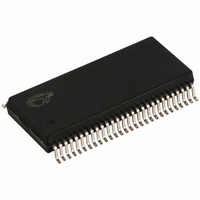CY7C66113C-PVXC Cypress Semiconductor Corp, CY7C66113C-PVXC Datasheet - Page 17

CY7C66113C-PVXC
Manufacturer Part Number
CY7C66113C-PVXC
Description
IC MCU 8K USB HUB 4 PORT 56TSSOP
Manufacturer
Cypress Semiconductor Corp
Specifications of CY7C66113C-PVXC
Applications
USB Hub/Microcontroller
Core Processor
M8
Program Memory Type
OTP (8 kB)
Controller Series
USB Hub
Ram Size
256 x 8
Interface
I²C, USB, HAPI
Number Of I /o
31
Voltage - Supply
4 V ~ 5.5 V
Operating Temperature
0°C ~ 70°C
Mounting Type
Surface Mount
Package / Case
56-SSOP
No. Of I/o's
31
Eeprom Memory Size
8KB
Ram Memory Size
256Byte
Cpu Speed
48MHz
Digital Ic Case Style
SSOP
Supply
RoHS Compliant
Core Size
8bit
Program Memory Size
8KB
Oscillator Type
External, Internal
Peripherals
DAC
Rohs Compliant
Yes
Controller Family/series
(8051) USB
Embedded Interface Type
HAPI, I2C, USB
Processor Series
CY7C66xx
Core
M8
Data Bus Width
16 bit
Data Ram Size
256 B
Interface Type
HAPI, I2C, USB
Maximum Clock Frequency
12 MHz
Number Of Programmable I/os
39
Number Of Timers
1
Maximum Operating Temperature
+ 70 C
Mounting Style
SMD/SMT
Development Tools By Supplier
CY3654, CY3654-P03
Minimum Operating Temperature
0 C
Lead Free Status / RoHS Status
Lead free / RoHS Compliant
For Use With
CY3649 - PROGRAMMER HI-LO USB M8428-1339 - KIT LOW SPEED PERSONALITY BOARD
Lead Free Status / Rohs Status
Details
Other names
428-1808
Available stocks
Company
Part Number
Manufacturer
Quantity
Price
Company:
Part Number:
CY7C66113C-PVXC
Manufacturer:
HITTITE
Quantity:
101
Part Number:
CY7C66113C-PVXC
Manufacturer:
CIRRUS
Quantity:
20 000
GPIO Configuration Port
Every GPIO port is programmed as inputs with internal pull ups, outputs LOW or HIGH, or Hi-Z (floating, the pin is not driven internally).
In addition, the interrupt polarity for each port is programmed. The Port Configuration bits
(Figure 10
GPIO Configuration
As shown in
represents a rising edge interrupt (LOW to HIGH), and a negative
polarity on an input pin represents a falling edge interrupt (HIGH
to LOW).
The GPIO interrupt is generated when all of the following
conditions are met: the Interrupt Enable bit of the associated Port
Interrupt Enable Register is enabled, the GPIO Interrupt Enable
bit of the Global Interrupt Enable Register
the Interrupt Enable Sense (bit 2,
pin of the port sees an event matching the interrupt polarity.
Table 6. GPIO Port Output Control Truth Table and Interrupt Polarity
Q1, Q2, and Q3 discussed here are the transistors referenced in
Figure
■
■
Document Number: 38-08024 Rev. *D
Port Config Bit 1 Port Config Bit 0 Data Register Output Drive Strength Interrupt Enable Bit
Bit #
Bit Name
Read/Write
Reset
Output LOW Mode: The pin’s Data Register is set to ‘0’
Output HIGH Mode: The pin’s Data Register is set to 1 and the
Port Configuration Bits[1:0] is set to ‘10’
Writing ‘0’ to the pin’s Data Register puts the pin in output
LOW mode, regardless of the contents of the Port
Configuration Bits[1:0]. In this mode, Q1 and Q2 are OFF. Q3
is ON. The GPIO pin is driven LOW through Q3.
In this mode, Q1 and Q3 are OFF. Q2 is ON. The GPIO is
pulled up through Q2. The GPIO pin is capable of sourcing
current.
7. The available GPIO drive strength are:
1
1
0
0
through
7
Port 3
Config Bit 1
R/W
0
Table
Figure
6, a positive polarity on an input pin
16) determine the interrupt polarity of the port pins.
1
0
1
0
6
Port 3
Config Bit 0
R/W
0
Figure
28) is set, and the GPIO
(Figure
Figure 12. GPIO Configuration Register
5
Port 2
Config Bit 1
R/W
0
0
1
0
1
0
1
0
1
29) is enabled,
Output LOW
Resistive
Output LOW
Output HIGH
Output LOW
Hi-Z
Output LOW
Hi-Z
4
Port 2
Config Bit 0
R/W
0
The driving state of each GPIO pin is determined by the value
written to the pin’s Data Register
and by its associated Port Configuration bits as shown in the
GPIO Configuration Register
configured on a per port basis, so all pins in a given port are
configured together. The possible port configurations are
detailed in
configured with CMOS outputs, interrupts from that port are
disabled.
During reset, all the bits in the GPIO Configuration Register are
written with ‘0’ to select Hi-Z mode for all GPIO ports as the
default configuration.
■
■
Resistive Mode: The pin’s Data Register is set to 1 and the Port
Configuration Bits[1:0] is set to ‘11’
Hi-Z Mode: The pin’s Data Register is set to1 and Port
Configuration Bits[1:0] is set either ‘00’ or ‘01’
Q2 and Q3 are OFF. Q1 is ON. The GPIO pin is pulled up with
an internal 14 kΩ resistor. In resistive mode, the pin may serve
as an input. Reading the pin’s Data Register returns a logic
HIGH if the pin is not driven LOW by an external source.
Q1, Q2, and Q3 are all OFF. The GPIO pin is not driven
internally. In this mode, the pin may serve as an input.
Reading the Port Data Register returns the actual logic value
on the port pins.
3
Port 1
Config Bit 1
R/W
0
Table
6. As shown in this table, when a GPIO port is
CY7C66013C, CY7C66113C
2
Port 1
Config Bit 0
R/W
0
(Figure
0
1
0
1
0
1
0
1
12) and the Interrupt Enable bit
(Figure
1
Port 0
Config Bit 1
R/W
0
(Figure 8
Disabled
– (Falling Edge)
Disabled
Disabled
Disabled
– (Falling Edge)
Disabled
+ (Rising Edge)
10). These ports are
Interrupt Polarity
through
ADDRESS 0x08
0
Port 0
Config Bit 0
R/W
0
Page 17 of 59
Figure
11)
[+] Feedback












